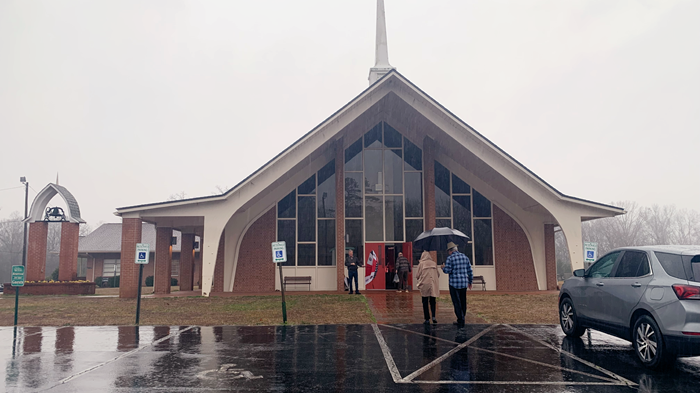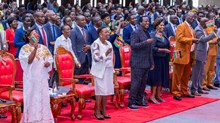
June Fulton felt weird sitting in the third pew.
At every service since she joined the choir when she was 12 years old—her whole life, basically—she has sat with them on the stage behind the pulpit at Mt. Vernon United Methodist Church (UMC), in Trinity, North Carolina.
But there was no singing at the disaffiliation vote. So Fulton, now one of the matriarchs at Mt. Vernon, took a spot in the pew next to a friend.
“Everybody filled out their piece of paper, a ballot, and they had to sign it,” Fulton told CT. “Every person went up and put their paper in the basket and then we sat there quietly. So quietly. It was so strange to sit there so quietly as we waited.”
Representatives from the denomination collected the ballots. They went into a back room and counted the votes to see whether the small rural church would be one of the thousands to exit the UMC over LGBTQ affirmation, fidelity to traditional Christian teachings on sexuality, the authority of the Book of Discipline, and years of bruising ecclesial conflict.
Fulton leaned over to her friend and said how sad it all was. She said this was not something you ever wanted to do.
Her friend said, “I just wonder what it’s going to be like. I think we’ve made the right decision. But I just wonder what it’s going to be like,” Fulton recalled.
Fulton wondered that too. She hoped the congregation would soon put it all behind them—the debates; the acrimony and the weight of it; the sorrow; and the endless, complex process of disaffiliation.
“We can go forward,” she said, “and go back to doing the things we always did do: caring for people, looking after people, and being the church.”
Mt. Vernon did vote to leave. Today, almost a year later, there are only a few remaining indications that this congregation used to be part of the mainline church that was one of the largest, most powerful, and most influential Protestant groups in the US. A beat-up road sign about a mile down the rural highway has the denomination’s name and logo and directions to the church. The hymnals in the pew still say United Methodist.
But Mt. Vernon, like 7,630 other churches, is free of the UMC. Thirty-three percent of the denomination’s congregations in Western North Carolina have left, along with more than half of those in Texas, 38 percent in Pennsylvania, 35 percent in Ohio, and nearly a third in Indiana.
Across the country, the newly separated Methodists are hoping for, praying for, and pursuing renewal. They are, as Fulton hoped, moving forward and going back.
Ten miles away from Trinity, at Wesley Memorial Methodist Church in High Point, North Carolina, Brenda Radner was one of about 300 people who attended a two-day seminar on Methodist identity in February, with lectures on Wesleyan history, theology, ethics, and hermeneutics. She started attending Wesley Memorial 56 years ago, when she was just 19. But the congregation’s recent exit from the UMC has made her want to dig deeper into Wesleyanism and learn more about the distinctives of her faith tradition.
It’s exciting, Radner told CT, to think about what might happen next.
“I would love to see revival. And I think it might come. I would love to see it start right here in High Point,” she said.
Revival is one of the explicit goals of the School of Methodism, put on by The John Wesley Institute. The first two-day event was held at Wesley Memorial, and there are half a dozen more being planned at other churches this spring and summer, according to director Ryan Danker.
The first one began with a call to worship. Hundreds of Methodists stood in the neo-gothic church to sing the great Charles Wesley hymn, “O for a Thousand Tongues.”
Before Communion, the assembled believers lifted their voices again with another classic from the cofounder of Methodism, singing out an invitation to new life.
“Come all the world! Come, sinner, thou! All things in Christ are ready now,” they sang. “Come all ye souls by sin oppressed, ye restless wanderers after rest.”
The event was attended by many North Carolinian members of the new Global Methodist Church, which is in the process of forming out of a split with the UMC. But it was also attended by members of UMC congregations, as well as people from the Anglican Church in North America, some as-yet-unaffiliated congregations, and perhaps a few people from the Church of the Nazarene, the Wesleyan Church, and the Free Methodist Church.
Danker talked about their common history in his opening lecture in the High Point sanctuary. He pointed them back to their original ethos, formed in the 18th-century Methodist revival fires that swept through Great Britain, the US, and the world.
“I’ve noticed recently, wherever I go—I speak to all kinds of Methodists—there’s a desire for the vibrancy of early Methodism,” he said. “What I want to do with my time here is provide something of a blueprint for Methodist revival.”
Danker urged all Methodists to look to that history for the fire pit, dry wood, and kindling that the Holy Spirit can set aflame.
The next day, Asbury University professor Suzanne Nicholson talked about recovering John Wesley’s approach to reading Scripture. Too many people, she told the gathered Methodists, have been led astray and distracted by debates about technical terms in hermeneutics, forgetting what the Bible is actually for.
“John Wesley was saying that God wants to transform us, and Scripture will transform us,” Nicholson said. “Scripture is the trustworthy revelation of the mind of God.”
The traditional Methodist approach to the Bible is literalist, according to Nicholson, but that doesn’t mean Wesley or other early Methodists like Peter Cartwright and Francis Asbury read everything literally. Instead, they accepted the plain meaning of the text, which involves an assessment of the genre of writing, the literary and historical contexts, and the larger story of Scripture, moving from original sin to justification by faith, new birth, and inward and outward holiness.
Methodists should read commentaries alongside Scripture, Nicholson said, and pray and ask for illumination from the Spirit. They should also look back to Wesley’s historic Bible-reading practices.
“One of the things we find with Wesley’s sermons is they’re just dripping with Scripture,” she said.
Several women attending the School of Methodism said they thought the greatest hope for Wesleyan renewal and revitalization would come from the deep commitment to the Bible that Nicholson talked about.
“We’ve kind of got to immerse ourselves and be in the Word,” said Catherine Fulcher, who attends Wesley Memorial.
Her friend Angie Fary agrees. As someone who grew up Baptist before joining the UMC 20 years ago, Fary appreciates learning more about the history and tradition of John Wesley and early Methodism. But she said she was especially encouraged, in this time of transition, to hear the speakers pointing Methodists back to the Bible.
“We’re going to stay the course in God’s Word,” Fary told CT.
Some Global Methodist leaders have also been directing a lot of energy toward prayer. They say they want the new denomination to be bound together less by bureaucracy and legal arrangements and more by intercession.
Laura Ballinger, an Indiana pastor on the Global Methodist’s prayer steering committee, said representatives from the new denomination’s different regions gather every month to pray. There are also groups in each region that are praying, and more on the local level. The church encourages each congregation to appoint a “prayer point person.”
The people in the pews of Global Methodist churches are urged to remember that they are dependent on God and that this new, fresh expression of Methodism will need his enabling, empowering, and sustaining grace.
“We want Jesus to be Lord, so we have to listen to him, and pray to him, and ask for empowerment,” Ballinger told CT. “We want to be a church—truly be a church—that is connected to each other and the Lord through prayer.”
Many people fasted and prayed for weeks prior to the convening conferences that formalized the regional organization of the Global Methodists. According to Ballinger, the meetings have been marked by extended times of prayer and an overflow of the fruit of the Spirit, especially love and joy.
“I saw people weeping with intense joy,” Ballinger said. “At a business meeting.”
The prayer requests ahead of the convening conference of the Great Lakes region focused mainly on practical concerns. Methodists were asked to pray that the conference would go smoothly, that registration would be orderly and efficient, and that everything spoken onstage would edify the church.
But the people on the prayer list were also asked to ask God for an outpouring of the Spirit and for each person present to be “alert to the Lord.”
Carol Perry, a member of Grace Methodist Church in Decatur, Illinois, said that as she drove home, she thought about how every face seemed filled with joy and how there was so much love, even from people she didn’t know. It was a powerful religious experience.
“I think part of the joy came from the freedom we have … because we are truly following Jesus and the church he is building,” Perry wrote. “I have only been following Jesus for about nine years. Freedom in Christ is a phrase I’ve heard a lot but really haven’t experience in such a profound way.”
The regional conference kind of seemed, in the words of another Methodist hymn writer, like “a foretaste of glory divine.”
Back in Trinity, North Carolina, the new Global Methodist pastor was preaching on that theme on a rainy February morning. Caroline Franks told the Mt. Vernon congregation about a recent meeting she’d had with people interested in being ordained in the Global Methodist Church.
“They’ve heard what God is doing among us, this remnant movement,” she said.
The denomination is still being formed, according to Franks, and the renewal of Methodism is just starting to take hold. But if they look now, the Mt. Vernon congregation can just catch sight of the great work God is doing. Franks compared it to the experience of the disciples who saw Jesus transfigured on a mountaintop.
“This is a preview, a sneak peak, a glimmer of what God is going to fulfill,” she said. “It’s a glimpse of God’s glory. A glimpse of what grace really is.”
Back in the choir on the piano side of the stage, June Fulton believed this. She thought it felt right. So this is what it is like, she thought. She couldn’t wait to see more of the new life this renewal would bring to the Methodist congregation she has belonged to since she was born.
“We really don’t know all the ins and outs of what will happen,” Fulton told CT. “But we’re united again, and I hope we will grow. We are wanting to build a new fellowship hall and of course we’re wanting to reach out into the community. We’ll have to see what will happen—but it’s exciting.”

Support Our Work
Subscribe to CT for less than $4.25/month


















